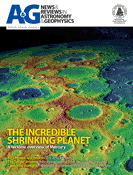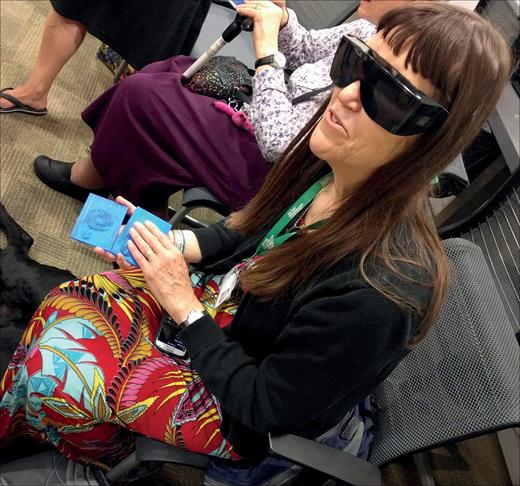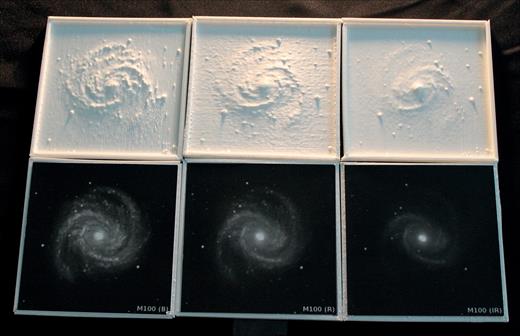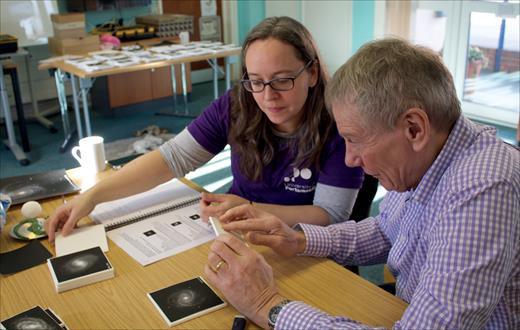-
PDF
- Split View
-
Views
-
Cite
Cite
Nicolas J Bonne, Jennifer A Gupta, Coleman M Krawczyk, Karen L Masters, Tactile Universe makes outreach feel good, Astronomy & Geophysics, Volume 59, Issue 1, February 2018, Pages 1.30–1.33, https://doi.org/10.1093/astrogeo/aty028
Close - Share Icon Share
Nicolas J Bonne and the Tactile Universe team describe their work to engage the vision-impaired community with accessible astrophysics.
Astronomy is often considered to be the most observational science, with the result that people with vision impairments can easily feel excluded from the discipline. There are many challenges involved in communicating astronomy to a vision-impaired (VI) audience, including countering pre-established beliefs that accessing astronomy will be too difficult without sufficient vision, catering to a wide range of different vision impairments as well as very individual learning styles and strategies for adapting. Particularly in the UK, efforts to engage with this community through astronomy outreach activities have been limited and tend to focus on communicating general topics. Efforts to engage the community with current astronomical research are particularly rare.
The challenges involved with making information accessible to a vision-impaired audience means that this community is severely under-represented within the physics community. University physics students with VI are rare; specific statistics are not available in the UK, but through our work we have encountered only two studying physics so far. Research by the Royal National Institute of Blind People (RNIB) shows that the attainment levels of school pupils with VI are consistently much lower than those for all pupils.
The Tactile Universe is a public engagement project at the University of Portsmouth to engage the vision-impaired community with current astrophysics research carried out at the Institute of Cosmology and Gravitation (ICG). The project team is made up of Nic Bonne (principle investigator and blind astronomer), Coleman Krawczyk (technical lead), Jen Gupta (public engagement advisor) and Karen Masters (academic advisor).
The aim of Tactile Universe is to demonstrate to the VI community that astrophysics can be accessible to them and, in particular, raise the aspirations of young people with vision impairments. Several other projects exist to engage the VI community with general topics in astronomy, such as A Touch of the Universe, AstroSense and Touching Space. But we believe we are the first project to focus on opening up current astrophysics research to this audience.
The Tactile Universe has already had a demonstrable impact on the local VI community in Portsmouth (figure 1) through a series of interactions, including test sessions and a public event. It has also affected the astronomers who have been involved with the project, changing the way they choose to present their work to the wider public. As the project expands in scale, in terms of both geographical reach and content, we will continue to raise the aspirations of young people with vision impairments and demonstrate that astronomy and other STEM subjects are areas that they can pursue as interests or careers. A key element in this is that the project lead is a blind astronomer and therefore a tangible role model.
Julie Duffy, Portsmouth City Council Visual Impairment Officer and organizer of the Southsea Library VI support group, gives feedback on early tactile galaxy models. (Jen Gupta/Tactile Universe team)
As well as engaging and inspiring school-aged children, a longer-term goal is to increase the project's reach to adults with vision impairments, particularly those of working age. The RNIB reports that only 25% of registered blind and partially sighted people of working age are in employment, and that older people with sight loss are almost three times more likely to experience depression than people with good vision. Enabling these individuals to engage with a topic that they are likely to have felt excluded from may make a positive impact on their mental states and quality of life.
Underpinning research
The Tactile Universe focuses on engaging VI audiences with the research conducted by Dr Masters' research group at the ICG. A large fraction of research in this group is linked to Galaxy Zoo core research; the group also hosts a Zooniverse front-end developer. Research highlights include the discovery of red spirals as a significant population of galaxies (Masters et al. 2010), investigating the role of bars in turning spirals red (Masters et al. 2011), and studying the spatial distribution of galaxies with specific morphologies and colours using luminosity functions over a range of wavelengths (Bonne et al. 2015).
Much of this research is possible becasue of the increasing availability of large multiband galaxy surveys such as the Sloan Digital Sky Survey (SDSS; York et al. 2000), which have provided researchers with a wealth of visual information, including galaxy size, shape and colour. These properties are crucial to understanding the evolutionary histories and origins of galaxies.
Though the underlying physics that drives galaxy evolution is complex, many of the core concepts can be easily conveyed to non-specialists through examination of the shapes and colours of galaxies in images. If a galaxy is optically red, this usually indicates it is no longer forming stars; if optically blue, it must be forming stars. The optical colours of galaxies allow us to determine the types of stars that occupy different parts of galaxies; typically, for example, the cores of spirals are redder because they contain older stars than the bluer, younger spiral arms. Star-formation properties often are linked to shape and overall light distribution; if a galaxy is young and star-forming, it is most likely to be disc-shaped and have visible spiral structure, whereas if its structure and distribution of light is more uniform and smoother, it is likely to be a much older object. Distorted or “messy” objects are examples of galaxies that have undergone (or are currently undergoing) interactions or other more subtle physical processes, that are changing their shape and possibly driving galaxy evolution. They often also have significant star-formation (and so are blue).
Tactile models
The core resource that has been developed by the Tactile Universe is three-dimensional representations of two-dimensional images of galaxies, which are created using a 3D printer. These tactile models were made by taking a single-band image of a galaxy and creating a height map based on the brightness of each pixel. More specifically, the faintest (black) pixels are set to the base level (0 mm), and the brightest (white) pixels are set to the maximum projection height (3 mm) above the base. The final result is similar to a relief map. The 3D models were created using Blender (http://www.blender.org), a freeware 3D modelling program, in combination with a custom plugin developed by Krawczyk. A more detailed and technical description of the 3D modelling and printing of the tactile models will appear in Krawczyk et al. (in prep.).
We have created tactile models of 13 morphologically distinct galaxies to date: M31/NGC 224, M51/NGC 5194+NGC 5195, M74/NGC 628, M81/NGC 3031, M88/NGC 4501, M91/NGC 4548, M100/NGC 4321, M101/ NGC 5457, M105/NGC 3379, M109/ NGC 3992, M110/NGC 205, NGC 2841 and NGC 5866. This range includes some of the typical types of galaxies and allows discussions of galaxy morphologies and concepts such as inclination. To convey ideas relating to galaxy structure, and emphasize different stellar content within galaxies, we made three models of each galaxy, using three different filters: blue, red and near-IR.
The raw galaxy images were sourced from the European Southern Observatory (ESO) Archive Digitized Sky Survey 2 (DSS2). These images were log-scaled and their brightness and contrast were adjusted consistently across all images to produce the best tactile/viewing results. As much as possible, we have tried to leave images as they were observed, including blemishes such as image artefacts, satellite trails and excessive noise, so that users experience the real data.
Development, testing and delivery
Throughout the process of developing and refining our Tactile Universe resources, we are working with representatives from VI support charities and VI education experts, as well as members of our local VI community in Portsmouth. The first six months (July 2016 to January 2017) of the Tactile Universe project were funded by a South East Physics Network (SEPnet) public engagement grant, and served as a pilot project to test and develop ideas, with the goal of holding a public event for the VI community in Portsmouth.
With input from the VI community, we determined the best projection height and overall size for the 3D printed tactile models. Several features of our tactile models have been included as a direct result of this consultation process, including having raised borders on the models that match the maximum projection height (to be used as a guide to more easily determine the relative brightness of any part of the model) and attaching a printout of the single-band galaxy image to the back of the tactile model, which is oriented so that users with some vision can see the galaxy image while simultaneously feeling the tactile model on the other side (figure 2).
Some 3D relief maps and their visual-image counterparts. (Coleman Krawczyk/Tactile Universe team)
As well as this consultation about the physical 3D tactile models, we have worked with the VI community to test and develop the content of the workshops and activities that we will use with the models. It became clear during the initial testing phase that with so many different types of vision impairment, and so many different learning styles and strategies for adapting, every individual we could make contact with would provide a unique perspective. This also means that we are committed to continually refining and adapting our resources depending on the specific needs of different audiences.
Between September and November 2016 we held three test sessions with adult members of the Southsea Library Vision Impairment Support Group. Their feedback was instrumental in testing our models and developing our activities around them, as well as developing and honing the language and communication skills that we needed to convey our ideas in an accessible way. We learnt, for example, that we needed to tie a physical explanation (i.e. the temperature of stars) to any mention of colour in galaxies, because anybody who has been blind from birth will not have a concept of colour in the way that a partially or fully sighted person will.
Through working with this group, particularly its older members, we were also able to gauge their level of knowledge and interest in astronomy before and after our sessions. Overall we found that the knowledge of astronomy among these adults with VI was much lower than we would usually encounter at public events. Some of our volunteers remembered studying astronomy at school, but had not gone on to learn any more as a result of their vision impairments. In some cases this had come about because of suggestions from their teachers or friends in well-meaning attempts to save them from a difficult or frustrating experience. Some had never learnt anything about astronomy and space for the same reason. One participant we spoke to was “afraid” of space because she knew so little about it. By the end of the session she had completely changed her attitude towards the subject and was asking when we were coming back again. Our experiences when discussing astronomy during these test sessions made us realize that we would not be able to jump straight into talking about galaxies with this audience, but would have to build up a base knowledge of astronomy first.
We also encountered a small number of individuals within the group who were actively hostile to the idea of learning anything about astronomy at all. This attitude can be encountered anywhere in outreach; for the VI community, we felt that this was an area of knowledge which they had been told they could not access and we had to convince them that it was worth accessing.
In January 2017, we held a public Tactile Universe event in Portsmouth, where we repeated several 1.5-hour sessions. Each session began with an interactive introduction talk used to give participants some basic astronomy information. This focused on concepts such as the difference between a planet and a star, sizes and distances in space from relatable local distances to the intergalactic scale. We incorporated a number of additional props such as a tactile globe of the Earth, a tactile star field, and toy models of spiral and elliptical galaxies. The second part of the session was a galaxy-sorting exercise using the tactile models we had developed. To allow for different levels of vision and learning styles, each participant was paired with a researcher from the ICG, allowing them to progress through the workshop material at their own speed (figure 3).
Karen Masters helps attendee Brian Anderson at a public event. (Jen Gupta/Tactile Universe team)
Feedback from the event regarding the individual assignment of demonstrators was overwhelmingly positive. Participants also appreciated the introduction, as they felt they could relate to the analogies being used, and it gave them the background knowledge they needed to use the more complicated tactile galaxy images. Some attendees reported an increased interest in astronomy after attending the event, though others reported that they did not follow up on this. This highlights the need for continued engagement and follow-up sessions, rather than stand-alone events.
Schools engagement
Our first test of the project in a classroom setting arose as a bit of a surprise during the pilot phase. In November 2016, the University of Portsmouth hosted one of the UK Space Agency's Principia Education Conferences, where school pupils were invited to attend a day of activities linked to space and astronaut Tim Peake's Principia mission, present their work on the mission and meet Peake. A few weeks before the event, we were informed that one of the children attending the event was a Year 6 pupil with total sight loss. At the time we were focused on creating content for the public Tactile Universe event, but we decided to adapt the ICG's existing schools outreach activity based on galaxy sorting to run at the Principia event for her and her group.
The galaxy-sorting activity is usually used as an introduction to the Galaxy Zoo citizen science project. Participants examine cards with images of galaxies on them and come up with their own galaxy classification scheme based on properties such as morphology and colour. Working with our tactile models instead of the image cards, the pupil with VI was able to participate fully in the activity alongside her classmates. “The 3D printed galaxies session was even better than meeting Tim Peake,” she said after the event. “Working with Dr Nic made me realize I could do science at university myself, and maybe even get a job as a scientist.” This feedback was our first indication of how much influence our project could have on the attitudes of young people with VI towards STEM subjects, and the potential impact that the Tactile Universe could have on this community.
The focus of the Tactile Universe has now shifted towards engaging with school pupils, particularly those in late primary/early secondary school. This decision was heavily influenced by the positive experience described above, and additional experiences of working with young VI people in the USA. Working with students will allow us to build a knowledge base over a series of sessions; we also hope that we will not encounter the difficulties we encountered during the pilot phase with adults who felt barriers to engaging with astronomy.
The project has two years of funding from the University of Portsmouth to engage with schools in our local area, and we are seeking additional funding to allow us to expand the geographical reach of the project across the UK. During the 2017/18 school year, we are creating and refining activities and lesson plans for children in Key Stages 2 and 3 (age 7–14) that use our 3D tactile galaxy models. We are working closely with one primary and one secondary mainstream (as opposed to VI specialist) school in Hampshire, both of which offer strong support for VI students, to test and develop these resources to ensure that they are suitable for the intended audience.
To make sure that our resources will work in specialist VI as well as mainstream schools, we are developing lesson plans for VI classrooms, as well as mixed VI and sighted classrooms. In the latter, a mixture of visual, tactile and audio resources will allow all students present to work on the same activity at the same time.
Next steps for the Tactile Universe
Our two main aims for the future are to make our tactile models and resources available to any school pupil with VI in the UK, and to offer a consultancy service to any other researchers in the UK who would like to engage the VI community with their own research. The first goal will be achieved through production of a “starter kit” that will contain everything, digital or physical, needed to use the Tactile Universe as a teaching resource. Subject to funding, these kits will be distributed to schools, universities and other outreach providers for free. To fulfill our second aim, we intend to change the way that researchers and public engagement professionals across the UK communicate their ideas and research. To help us in these goals, we continue to rely on collaboration with the VI community. To this end, we have formed a partnership with the RNIB, which will offer support in four key areas:
providing advice and feedback on the suitability of our 3D tactile models and activities as we develop them;
spreading awareness of the project by advertising the project to relevant schools/teachers/networks, e.g. the Qualified Teacher of children and young people with a Vision Impairment (QTVI) teachers;
working with us in different areas of the UK to create networks between schools, universities, and other support organizations to ensure that our resources are accessible to all young people; and
providing advice and feedback on how to evaluate the project using accessible methods to gauge the effectiveness of the project.
In December 2017, the RAS and Tactile Universe co-organized a VI public engagement meeting, featuring speakers from several VI public engagement projects from around the UK. It provided a forum for people to network and share ideas, as well as form future collaborations. This event will be covered in more detail in a future RAS publication, but it is our sincere hope that this type of meeting becomes a recurring event and will continue to bring together VI outreach and public engagement project members from across the UK.
Legacy
As well as our efforts to reach VI students nationally, we want to ensure that the project has an impact and legacy beyond the next few years. We will create and make public our documentation for all aspects of the project, including activity plans and 3D printing instructions. Everything that we create will be released freely under a Creative Commons licence. Subject to funding, we will run training sessions for outreach officers, astronomers and educators nationwide, so that anybody who wants to run our activities will feel comfortable doing so. Our hope is that astronomy departments will incorporate these activities into their outreach programmes; this is already happening in South America, where a team led by Dr Maria Argudo-Fernandez at the University of Antofagasta in Chile has successfully secured funding from the IAU Office of Astronomy for Development to use our resources. In addition, teachers with no background in astronomy will be able to use our resources with the help of our detailed supporting documentation.
While we are now focusing on developing ways to use our Tactile Universe resources in schools, we have discovered that our 3D galaxy models are versatile and can be used in various situations. The Tactile Universe has attended a variety of public events, from the ICG's Stargazing at Portsmouth's Historic Dockyard, to the science tent at Victorious Music Festival. The project has been a success with both VI and fully sighted members of the public at these events, as it provides participants with something to interact with, as well as providing a different way of learning about galaxies and accessing information. By releasing all of the materials publicly, we hope that others will come up with even more innovative ways to use our resources.
ACKNOWLEDGMENTS
We would like to acknowledge the South East Physics Network Public Engagement Grant, which funded the Tactile Universe pilot project in 2016, and the SEPnet Impact Grant, which will fund an investigation of more efficient tactile model production methods in 2018. We would also like to acknowledge funding from the RAS to present the Tactile Universe at The 3rd Symposium on Universal Design for Astronomy Education, held in Japan in 2016. DSS2 data, as obtained from the ESO Archive and used in this project, is based on photographic data of the National Geographic Society–Palomar Observatory Sky Survey (NGS-POSS) obtained using the Oschin Telescope on Palomar Mountain. The NGS-POSS was funded by a grant from the National Geographic Society to the California Institute of Technology. The plates were processed into the present compressed digital form with their permission. The Digitized Sky Survey was produced at the Space Telescope Science Institute under US Government grant NAG W-2166.
MORE INFORMATION
The Tactile Universehttp://tactileuniverse.org
Twitter: @TactileUniverse
A Touch of the Universehttp://astrokit.uv.es
Astrosensehttp://astro4dev.org/oad-activities/astrosense
Touching Spacehttp://bit.ly/2lDgr76
Galaxy Zoohttp://galaxyzoo.org
REFERENCES
Author notes
The Tactile Universe project is run by PI Nicolas J Bonne (nicolas.bonne@port.ac.uk), Jennifer A Gupta, Coleman M Krawczyk






